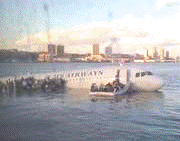Bird Strike Committee Proceedings
Date of this Version
8-2008
Abstract
Removal of red-tailed hawks and other raptors by trapping and relocating, euthanasia, or other techniques is often used by airport managers to address hazardous birds, however many professionals disagree about the effectiveness of this approach. Relocating birds has drawbacks due to expense, site fidelity leading to returning birds, and other issues. Lethal control methods suffer from permitting requirements and may lead to adverse public opinion. Removing birds by relocation or lethal means often results in other individuals, including inexperienced juveniles, attempting to fill vacated territories, with smaller territories, higher densities, and birds that may be less adept at avoiding aircraft traffic. The Louisville Kentucky Waste Management Outer Loop Recycling and Disposal Facility (WMOLRDF) operates an aggressive bird control program to minimize potential impacts to the nearby Louisville International Airport. Early management efforts in the program focused on raptor removal through lethal means with limited non-lethal harassment. During that time, average daily raptor observation counts remained low and relatively stable; however, the number of raptors lethally removed on a monthly basis exceeded those observed during average daily counts, clearly indicating that new birds were filling vacated territories. A moratorium imposed by Waste Management on killing raptors (and several other species) began at the landfill in October 2005. Nonlethal harassment efforts targeting Red-tailed Hawks were implemented that include coordinated habitat management, intensive pyrotechnic harassment, installation of anti-perching devices, and use of an innovative Long Range Acoustic Device (LRAD). The results have been very positive with raptor counts declining, indicating a training effect and territorial defense by adult resident birds. This paper and presentation summarizes the results of the program, contrasting non-lethal versus lethal methods.


Comments
Abstract of paper presented at Bird Strike Committee USA/Canada Meeting, Lake Mary and Sanford, Florida, August 18–21, 2008.